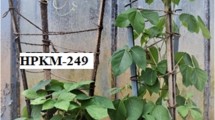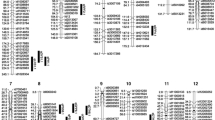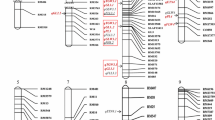Abstract
A genetic linkage map has been developed for recombinant inbred lines (RILs) of the cross 'Arta' × Hordeum spontaneum 41-1. One hundred and ninety four RILs, randomly chosen from a population of 494 RILs, were mapped with 189 markers including one morphological trait (btr = brittle rachis locus). The linkage map extended to 890 cM. Agronomic traits such as grain yield, biological yield, days to heading, plant height, cold tolerance and others were evaluated at the ICARDA research stations Tel Hadya and Breda during the years 1996–97 and 1997–98. QTLs for agronomic traits related to drought resistance were localized. For the most-important character 'plant height under drought stress', QTLs on 2H, 3H and 7H were detected. The 'plant height' QTLs, specially the one on 3H, showed pleiotropic effects on traits such as days to heading, grain yield and biological yield. QTLs were also identified for other traits associated with adaptation to the Mediterranean environment such as cold tolerance, days to heading and tiller number. The identification of QTLs for agronomic traits is a first step to analyze and to dissect complex characters such as adaptation to drought tolerance.

Similar content being viewed by others
References
Araus JL, Bort J, Ceccarelli S, Grando S (1997) Relationship between leaf structure and carbon isotope discrimination in field-grown barley. Plant Physiol Biochem 35:533–541
Backes G, Jahoor A (2001) Wege zur Nutzung des genetischen Potentials der Wildgerste – mit molekularen Markern zu neuen Resistenzgenen. Bericht der Arbeitstagung der 52. Tagung der Vereinigung der Pflanzenzüchter und Saatgutkaufleute Österreich, Gumpenstein: 81–86
Backes G, Graner A, Foroughi-Wehr B, Fischbeck G, Wenzel G, Jahoor A (1995) Localization of quantitative trait loci (QTLs) for agronomic important characters by the use of a RFLP map in barley (Hordeum vulgare L.). Theor Appl Genet 90:294–302
Bassam BJ, Caetano-Anolles G, Gresshoff PM (1991) Fast and sensitive silver staining of DNA in polyacrylamide gels. Anal Biochem 196:80–83
Barua UM, Chalmers KJ, Thomas WTB, Hackett CA, Lea V, Jack P, Forster BP, Waugh R, Powell W (1993) Molecular mapping of genes determining height, time to heading, and growth habit in barley (Hordeum vulgare). Genome 36:1080–087
Bezant J, Laurie D, Pratchett N, Chojecki J, Kearsey M (1997) Mapping QTLs controlling yield and yield components in a spring barley (Hordeum vulgare L.) cross using marker regression. Mol Breed 3:29–38
Blum A (1988) Drought resistance. In: Plant breeding for stress environments. CRC Press, Boca Raton, Florida, pp 43–76
Bort J, Araus JL, Hazzam H, Grando S, Ceccarelli S (1998) Relationships between early vigour, grain yield, leaf structure and stable isotope composition in field-grown barley. Plant Physiol Biochem 36:889–897
Cattivelli L, Baldi P, Crosatti C, Di Fonzo N, Faccioli P, Grossi M, Mastrangelo AM, Pecchioni N, Stanca AM (2002) Chromosome regions and stress-related sequences involved in resistance to abiotic stress in Triticeae. Plant Mol Biol 48:649–665
Ceccarelli S (1994) Specific adaptation and breeding for marginal conditions. Euphytica 77:205–219
Ceccarelli S, Grando S (1996) Drought as a challenge for the plant breeder. Plant Growth Reg 20:149–155
Ceccarelli S, Acevedo E, Grando S (1991) Breeding for yield stability in unpredictable environments: single traits, interaction between traits, and architecture of genotypes. Euphytica 56:169–185
Choi DW, Koag MC, Close TJ (2000) Map locations of barley Dhn genes determined by gene-specific PCR. Theor Appl Genet 101:350–354
Choi DW, Rodriguez EM, Close TJ (2002) Barley Cbf3 gene identification, expression pattern, and map location. Plant Physiol 129:1781–1787
Churchill GA, Doerge RW (1994) Empirical threshold values for quantitative trait mapping. Genetics 138:963–971
Ellis RP (2002) Wild barley as a source of genes for crop improvement. In: Slafer GA, Molin-Cano JL, Savin R, Araus JL, Ramagosa I (eds) Barley science: recent advances from molecular biology to agronomy of yield and quality. Food Products Press, The Haworth Press Inc, pp 65–83
Ellis RP, Nevo E, Beiles A (1993) Milling energy polymorphism in Hordeum spontaneum Koch in Israel and its potential utilization in breeding for malting quality. Plant Breed 111:78–81
Ellis RP, Forster BP, Gordon DC, Handley LL, Keith RP, Lawrence P, Meyer R, Powell W, Robinson D, Scrimgeour CM, Young G, Thomas WT (2002) Phenotype/genotype associations for yield and salt tolerance in a barley mapping population segregating for two dwarfing genes. J Exp Bot 2002:1163–1176
Farquhar GD, Ehleringer JR, Hubick KT (1989) Carbon isotope discrimination and photosynthesis. Annu Rev Plant Physiol Plant Mol Biol 40:503–537
Fischer RA (1979) Growth and water limitations to dryland wheat yield in Australia: a physiological framework. J Aust Inst Agric Sci 45:83–94
Fischer RA (1981) Optimizing the use of water and nitrogen through breeding of crops. Plant and Soil 58:249–278
Forster BP, Ellis RP, Thomas WTB, Newton AC, Tuberosa R, This D, El- Enein RA, Bahri H, Ben Salem M (2000) The development and application of molecular markers for abiotic stress tolerance in barley. J Exp Bot 51:19–27
Franckowiak JD, Lundqvist U, Konishi T (1997) New and revised names for barley genes. Barley Genet Newslett pp 26:4–8
Giles BE (1990) The effects of variation in seed size on growth and reproduction in the wild barley Hordeum vulgare ssp. spontaneum. Heredity 64:239–250
Giles BE, Bengtsson BO (1988) Variation in anther size in wild barley (Hordeum vulgare ssp. spontaneum). Hereditas 108:199–205
Grando S, Ceccarelli S (1995) Seminal root morphology and coleoptile length in wild (Hordeum vulgare ssp. spontaneum) and cultivated (Hordeum vulgare ssp. vulgare) barley. Euphytica 86:73–80
Grando S, von Bothmer R, Ceccarelli S (2001) Genetic diversity of barley: use of locally adapted germplasm to enhance yield and yield stability of barley in dry areas. In: Cooper HD, Spillane C, Hodgink T (eds) Broadening the genetic base of crop production. CABI/FAO/IPGRI, pp 351–372
Graner A, Jahoor A, Schondelmaier J, Siedler H, Pillen K, Fischbeck G, Wenzel G, Herrmann RG (1991) Construction of an RFLP map of barley. Theor Appl Genet 83:250–256
Gustafsson M, Claesson L (1988) Resistance to powdery mildew in wild species of barley. Hereditas 108:231–237
Haley CS, Knott SA (1992) A simple regression method for mapping quantitative trait loci in line crosses using flanking markers. Heredity 69:315–324
Hayes PM, Liu BH, Knapp SJ, Chen F, Jones B, Blake T, Franckowiak J, Rasmusson D, Sorells M, Ullrich SE, Wesenberg D, Kleinhofs A (1993) Quantitative trait locus effects and environmental interaction in a sample of North American barley germplasm. Theor Appl Genet 87:392–401
Hayes PM, Castro A, Corey A, Marquez-Cedillo L, Jones B, Mather D, Matus I, Rossi C, Sato K (2000) A summary of published barley QTL reports. http://www.css.orst.edu/barley/NABGMP/qtlsum.htm
Hospital F, Moreau L, Lacoudre F, Charcosset A, Gallais A (1997) More on the efficiency of marker-assisted selection. Theor Appl Genet 95:1181–1189
Ivandic V, Forster BP, Hackett CA, Nevo N, Keith R, Thomas TBW (2002) Analysis of simple sequence repeats (SSRs) in wild barley from the Fertile Crescent: associations with ecology, geography and flowering time. Plant Mol Biol 48:511–527
Jahoor A, Fischbeck G (1987) Sources of resistance to powdery mildew in barley lines derived from Hordeum spontaneum collected in Israel. Plant Breed 99:274–281
Jaradat AA (1991) Grain protein variability among populations of wild barley (Hordeum spontaneum C Koch) from Jordan. Theor Appl Genet 83:164–168
Kandemir N, Kudrna DA, Ullrich SE, Kleinhofs A (2000) Molecular-marker-assisted genetic analysis of head shattering in six-rowed barley. Theor Appl Genet 101:203–210
Komatsuda T, Mano Y (2002) Molecular mapping of the intermedium spike-c (int-c) and non-brittle rachis 1 (btr1) loci in barley (Hordeum vulgare L.). Theor Appl Genet 105:85–90
Kosambi DD (1944) The estimation of map distance from recombination values. Ann Eugen 12:172–175
Lander ES, Green P, Abrahamson J, Barlow A, Daly MJ, Lincoln SE, Newburg L (1987) Mapmaker: an interactive computer package for constructing primary genetic linkage maps of experimental and natural populations. Genomics 1:174–181
Laurie DA, Pratchett N, Romero C, Simpson E, Snape JW (1993) Assignment of the denso dwarfing gene to the long arm of chromosome 3 (3H) of barley by the use of RFLP markers. Plant Breed 111:198–203
Laurie DA, Pratchett N, Bezant JH, Snape JW (1995) RFLP mapping of 5 major genes and 8 quantitative trait loci controlling flowering time in a winter × spring barley (Hordeum vulgare L.) cross. Genome 38:575–585
Lehmann LC, Jönsson R, Gustafsson M (1998) Identification of resistance genes to powdery mildew isolated from Hordeum vulgare ssp. spontaneum and landraces of barley. J Swedish Seed Assoc 108:94–101
Marquez-Cedillo LA, Hayes PM, Kleinhofs A, Legge WG, Rossnagel BG, Sato K, Ullrich SE, Wesenberg DM (2001) The North American Barley Genome Mapping Project: QTL analysis of agronomic traits in barley based on the doubled-haploid progeny of two elite North American varieties representing different germplasm groups. Theor Appl Genet 103:625–637
Morgan JM (1983) Osmoregulation as a selection criterion for drought tolerance in wheat. Aust J Agric Res 34:607–614
Moseman JG, Nevo E, Zohary D (1983) Resistance of Hordeum spontaneum collected in Israel to infection with Erysiphe graminis hordei. Crop Sci 23:1115–1119
Moseman JG, Nevo E, El-Morsidy MA (1990) Reactions of Hordeum spontaneum to infection with two cultures of Puccinia hordei from Israel and United States. Euphytica 49:169–175
Nevo E (1992) Origin, evolution, population genetics and resources for breeding of wild barley, Hordeum spontaneum, in the Fertile Crescent. In: Shewry PR (ed) Barley: genetics, biochemistry, molecular biology and biotechnology, C.A.B. International, pp 19–43
Nevo E, Krugman T, Beiles A (1993) Genetic resources for salt tolerance in the wild progenitors of wheat (Triticum dicoccoides) and barley (Hordeum spontaneum) in Israel. Plant Breed 110:338–341
Pan A, Hayes PM, Chen F, Blake THH, Wright TKS, Karsai I, Bedö Z (1994) Genetic analysis of the components of winter hardiness in barley (Hordeum vulgare L.). Theor Appl Genet 89:900–910
Passioura JB (1986) Resistance to drought and salinity: avenues for improvement. Aust J Plant Physiol 13:191–201
Qi X, Stam P, Lindhout P (1996) Comparison and integration of four barley genetic maps. Genome 39:379–394
Ramsay L, Macaulay M, Degli Ivanissevich S, Maclean K, Carsle L, Fuller J, Edwards KJ, Tuvesson S, Morgante M, Massari A, Maestri E, Marmiroli N, Sjakste T, Ganal M, Powell W, Waugh R (2000) A simple sequence repeat-based linkage map of barley. Genetics 156:1997–2005
Saghai-Maroof MA, Soliman KM, Gorgensen RA, Allard RW (1984) Ribosomal DNA spacer-length polymorphism in barley: Mendelian inheritance, chromosomal location and population dynamics. Proc Natl Acad Sci USA 81:8014–8018
Stam P, Van Ooijen JW (1995) JoinMap version 2.0: software for the calculation of genetic linkage maps. CPRO-DLO, Wageningen
Tanno K, Taketa S, Takeda K, Komatsuda T (2002) A DNA marker closely linked to the vrs1 locus (row-type gene) indicates multiple origins of six-rowed cultivated barley (Hordeum vulgare L.). Theor Appl Genet 104:54–60
Teulat B, This D, Khairallah M, Borries C, Ragot C, Sourdille P, Leroy P, Monneveux P, Charrier A (1998) Several QTLs involved in osmotic adjustment trait variation in barley (Hordeum vulgare L.). Theor Appl Genet 96:688–698
Teulat B, Borries C, This D (2001a) New QTLs identified for plant water status, water-soluble carbohydrates, osmotic adjustment in a barley population grown in a growth-chamber under two water regimes. Theor Appl Genet 103:161–170
Teulat B, Merah O, Souyris I, This D (2001b) QTLs for agronomic traits from Mediterranean barley progeny grown in several environments. Theor Appl Genet 103:774–787
Teulat B, Merah O, Sirault X, Borries C, Waugh R, This D (2002) QTLs for grain carbon isotope discrimination in field-grown barley. Theor Appl Genet 106:118–126
Thomas WTB, Powell W, Waugh R, Chalmers KJ, Barua UM, Jack P, Lea V, Forster BP, Swanston JS, Ellis RP, Hanson PR, Lance RCM (1995) Detection of quantitative trait loci for agronomic yield, grain, and disease characters in spring barley (Hordeum vulgare L.). Theor Appl Genet 91:1037–1047
Tinker NA, Mather DE, Rossnagel BG, Kasha KJ, Kleinhofs A, Hayes PM, Falk DE, Ferguson T, Shugar LP, Legge WG, Irvine RB, Choo TM, Briggs KG, Ullrich SE, Franckowik JD, Blake TK, Graf RJ, Dofing SM, Saghai Maroof MA, Scoles GJ, Hoffman D, Dahleen LS, Kilian, Chen F, Biyashev RM, Kudrna DA, Steffenson BJ (1996) Regions of the genome that affect agronomic performance in two-row barley. Crop Sci 36:1053–1062
Turner NC (1982) The role of shoot characteristics in drought resistance of crop plants. In: Drought resistance in crops with emphasis on rice. IRRI, Los Banos, The Philippines, pp 115–134
Utz HF, Melchinger AE (1994) Comparison of different approaches to interval mapping of quantitative trait loci. In: van Oojen JW, Jansen J (eds) Biometrics in plant breeding: application of molecular markers. Wageningen, 195–204
Utz HF, Melchinger AE (1996) PLABQTL: a program for composite interval mapping of QTLs. J Quant Trait Loci 2, http://www.ncgr.org/jag/papers96/paper196/indexp196.html
Van Ooijen JW, Maliepaard C (1996) MapQTL version 3.0: software for the calculation of QTL positions on genetic maps. CPRO-DLO, Wageningen
Yin X, Stam P, Johan Dourleijn C, Kropff MJ (1999) AFLP mapping of quantitative trait loci for yield-determining physiological characters in spring barley. Theor Appl Genet 99:244–253
Zhu H, Briceño G, Dovel R, Hayes PM, Liu BH, Liu CT, Toojinda T, Ullrich SE (1999) Molecular breeding for grain yield in barley: an evaluation of QTL effects in a spring barley cross. Theor Appl Genet 98:772–779
Zabeau M, Vos P (1993) Selective restriction fragment amplification: a general method for DNA fingerprinting. Eur Pat App 92402629.7 (Publ Number 0 534858 A1)
Acknowledgements
This research was funded by BMZ grant 96.7860.8-001.00, by a grant of the Arab Fund for Economic and Social Development, and by the grant of the Danish Research Council for Developmental Research (Proj.-No. 90978). We are grateful to Dr. W. Powell, SCRI, for providing barley microsatellite primer sequences prior to publication.
Author information
Authors and Affiliations
Corresponding author
Additional information
Comunicated by R. Hagemann
Rights and permissions
About this article
Cite this article
Baum, M., Grando, S., Backes, G. et al. QTLs for agronomic traits in the Mediterranean environment identified in recombinant inbred lines of the cross 'Arta' × H. spontaneum 41-1. Theor Appl Genet 107, 1215–1225 (2003). https://doi.org/10.1007/s00122-003-1357-2
Received:
Accepted:
Published:
Issue Date:
DOI: https://doi.org/10.1007/s00122-003-1357-2




